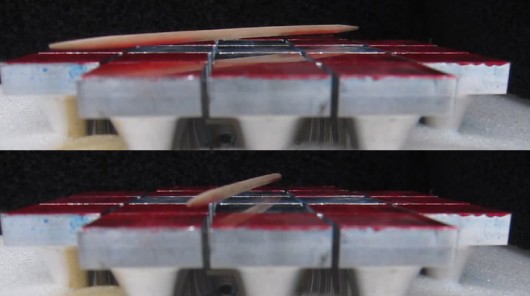Surfing on a wave of sound allows controlled movement of levitating objects
By Darren Quick
July 19, 2013

The movement of levitated objects - here a toothpick - is possible by varying the acoustic waves of several parallel emitter-reflector modules (Photo: Daniele Foresti / ETH Zurich)
With the exception of magic, the process of levitating objects generally relies on magnetism or electric fields. However, sound waves can also be used to cancel out the effects of gravity to suspend objects and droplets of liquid in mid air. For the first time, researchers at the Swiss Federal Institute of Technology Zurich (ETH) have been able to control the movement of such levitating objects. Besides looking cool, the technology has implications for the study of various chemical reactions and biological processes and the development and production of pharmaceuticals and electronics.
Unlike the acoustic levitator developed at the US Department of Energy’s Argonne National Laboratory, which is able to suspend droplets in mid air between two small speakers, the new technology developed by postdoctoral researcher at the Laboratory of Thermodynamics in Emerging Technologies at ETH, Daniele Foresti, allows the movement of suspended droplets and objects to be controlled so multiple droplets can be mixed in mid air or objects can be transported.
This allows droplets – both magnetic and non-magnetic – to be mixed without any potential contamination or interference from surfaces. It is also allows experimentation on certain substances that disintegrate when coming into contact with surfaces.
While it was discovered over 100 years ago that sound waves can exert enough force to keep an object suspended, controlling the motion of the suspended object through the air has proven more difficult. Forest succeeded where others had failed by switching on multiple emitter-reflector modules in parallel to each other. By varying the acoustic waves from module to module, he was able to transfer particles or droplets of liquid from one module to the next – essentially surfing them on a wave of sound.
Foresti told us that his system uses ultrasounds at 24 kHz, so is beyond the 20 kHz limit of human hearing – but within the hearing range of dogs. He says this wavelength limits the size of objects that can be levitated to 4 to 5 mm in diameter, but that the length of the object is theoretically unlimited. Also, “louder” acoustic waves allow denser materials, such as glass, ceramic, aluminum and steel to be levitated.
So far, Foresti and his team have successfully levitated drops of water, hydrocarbons, various solvents and even toothpicks. In one test they levitated a granule of instant coffee and a droplet of water before combining the two in mid air, while in another two droplets of liquid with different pH values were brought together to create a droplet that contained a fluorescent pigment that only glows at a neutral pH value.
Foresti says the technology could have a wide variety of applications including chemical and biological experiments that require particles or droplets to be initially processed and then analyzed without worrying about any chemical changes that can occur due to contact with a surface. The technique can also run in parallel with several objects, strengthening its potential for industrial applications.
A video demonstrating the controlled movement of levitating droplets can be found here.
Source: ETH
Copyright © gizmag 2003 - 2013 To subscribe or visit go to: http://www.gizmag.com
http://www.gizmag.com/control-movement-levitation-sound-waves/28377/